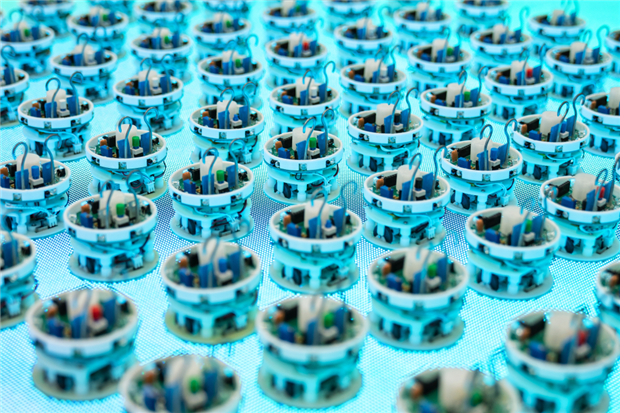These robots are programmed to search for food similarly to bacteria. (Image Credit: L. Liu/Chongqing University)
Researchers at Chongqing University in China have designed an analog experiment for bio-inspired robots, allowing them to explore and adapt to their environment. The team placed robots on an LED board with an adjustable light output, which imitates the number of consumable resources. When the robots consumed a resource, they moved out of the region. Afterward, it led to collective patterns resembling liquid, crystal, and glass. The team is planning on exploring the robot's ability to self-organize by providing them with a preference for consuming different light colors. These programmed robots could have medical applications in the future to study tumor cell development.
The researchers manufactured 8-cm-wide hockey-puck-shaped robots equipped with wheels and light sensors underneath. These robots are programmed to move in response to light beneath them. They traveled toward stronger light, where the brightness quickly intensified. Fifty robots were placed on a 4mx4m LED light board with independently controlled pixels.
Every robot's light dimmed for a certain amount of time over a specific area, which simulated how it absorbs a resource and recovers. Once dimming occurred, the robots rolled to a brighter area, which also dimmed upon their arrival. The researchers call this gradient-guided motion a warp drive since it warps the resource space surrounding a robot.
The team demonstrated that these robots repel each other since they tend to stay in bot-free areas where there are more resources. To study these interactions, the team built a circular light environment surrounded by darkness. It started with a large circle while the robots randomly moved around. Then, the researchers decreased its diameter, causing the robots to move closer together in a hexagonal crystalline pattern.
Each robot was confined to a small patch surrounded by six others. As the size decreased, the vacant regions started overlapping, creating a uniform light landscape where a robot wasn't drawn into a region. This caused the crystals to melt into a liquid-like phase and then a disordered, glass-like phase, where the robots were set in place while contacting the others.
This behavior has not been observed before in other active matter experiments. Upgrading the robots could provide biologically relevant behavior. The team has already started to add color sensitivity, which would allow some robots to forage for a red light while others consume blue light. These unique characteristics could be passed from one bot to the next during reproduction. The team also believes these robots could help shed light on tumor cell development.
Have a story tip? Message me at: http://twitter.com/Cabe_Atwell


Top Comments
-

dubbie
-
Cancel
-
Vote Up
0
Vote Down
-
-
Sign in to reply
-
More
-
Cancel
-

Catwell
in reply to dubbie
-
Cancel
-
Vote Up
+1
Vote Down
-
-
Sign in to reply
-
More
-
Cancel
Comment-

Catwell
in reply to dubbie
-
Cancel
-
Vote Up
+1
Vote Down
-
-
Sign in to reply
-
More
-
Cancel
Children